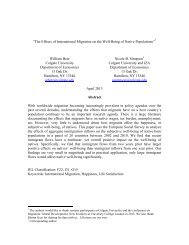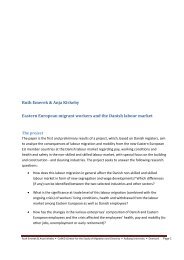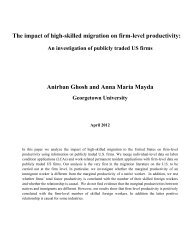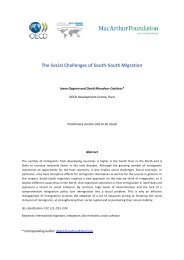The Role of Source- and Host-Country Characteristics in ... - CReAM
The Role of Source- and Host-Country Characteristics in ... - CReAM
The Role of Source- and Host-Country Characteristics in ... - CReAM
You also want an ePaper? Increase the reach of your titles
YUMPU automatically turns print PDFs into web optimized ePapers that Google loves.
For first-generation immigrants, we follow Bis<strong>in</strong> et al. (2011), Blau <strong>and</strong> Kahn (2011),<br />
<strong>and</strong> Blau et al. (2011) <strong>and</strong> measure source-country variables at the time these immigrants<br />
left that country. In do<strong>in</strong>g so, we are able to measure the norms <strong>and</strong> values immigrants<br />
grew up with <strong>and</strong> carry to their host country. We calculate the year the immigrant left<br />
the home country by us<strong>in</strong>g <strong>in</strong>formation on the year <strong>of</strong> observation <strong>and</strong> the immigrant’s<br />
years s<strong>in</strong>ce arrival <strong>in</strong> the host country. 15 S<strong>in</strong>ce the latter is not a cont<strong>in</strong>uous variable but<br />
is subdivided <strong>in</strong> predef<strong>in</strong>ed categories, we set years s<strong>in</strong>ce migration equal to the mid-po<strong>in</strong>t<br />
<strong>of</strong> each <strong>in</strong>terval <strong>and</strong> to the lower bound <strong>of</strong> the top <strong>in</strong>terval (i.e., 20 years). Thus, our<br />
source-country data for first-generation immigrants span the years 1982 to 2010.<br />
As Fernández <strong>and</strong> Fogli (2009) outl<strong>in</strong>e, the optimal po<strong>in</strong>t <strong>of</strong> time from which to take<br />
the respective values for second-generation immigrants is not obvious. On the one h<strong>and</strong>, it<br />
could be argued that the values <strong>of</strong> the culture proxy variables measured at the time the<br />
immigrant’s parents left their home country would best reflect the culture <strong>of</strong> the country<br />
<strong>of</strong> ancestry. <strong>The</strong> ma<strong>in</strong> problem with assign<strong>in</strong>g the source-country characteristics based on<br />
the year the immigrant’s parents left the country is that this <strong>in</strong>formation is not <strong>in</strong>cluded<br />
<strong>in</strong> our data. However, even if we were able to observe the parents’ year <strong>of</strong> arrival, data<br />
limitations would permit us to use years prior to 1960, s<strong>in</strong>ce values for most <strong>of</strong> our macro<br />
<strong>in</strong>dicators are not available prior to that year. Fernández <strong>and</strong> Fogli (2009) circumvent<br />
this problem by us<strong>in</strong>g the current values <strong>of</strong> the source country <strong>in</strong>dicators, argu<strong>in</strong>g that<br />
the values that parents <strong>and</strong> society transmit to second-generation immigrants might be<br />
best reflected by a comparison <strong>of</strong> what the counterparts <strong>of</strong> these women are do<strong>in</strong>g <strong>in</strong> the<br />
country <strong>of</strong> ancestry at the time <strong>of</strong> observation. We follow this approach, thereby mak<strong>in</strong>g<br />
sure that the macro <strong>in</strong>dicators are available for the majority <strong>of</strong> the source countries <strong>in</strong> our<br />
sample, as they span the years 2002 to 2011 only. A possible drawback <strong>of</strong> the outl<strong>in</strong>ed<br />
assignment rules is that we treat first- <strong>and</strong> second-generation immigrants differently, i.e.,<br />
we use current values <strong>of</strong> the macro <strong>in</strong>dicators for second-generation immigrants, while we<br />
assign past values <strong>of</strong> these <strong>in</strong>dicators to first-generation immigrants, mak<strong>in</strong>g a comparison<br />
<strong>of</strong> the behavior <strong>of</strong> both groups problematic. In order to assure that our results are not<br />
driven by these assignment rules, we therefore perform sensitivity analyses <strong>in</strong> which we use<br />
current <strong>in</strong>stead <strong>of</strong> past values <strong>of</strong> all macro <strong>in</strong>dicators for both first- <strong>and</strong> second-generation<br />
immigrants.<br />
<strong>The</strong> explanatory variables <strong>of</strong> our ma<strong>in</strong> <strong>in</strong>terest are F LF P R j <strong>and</strong> F LF P R k , the female<br />
labor force participation rates <strong>of</strong> the immigrant’s source <strong>and</strong> host country, respectively.<br />
<strong>The</strong> source-country FLFP rate covers the rate <strong>of</strong> the economically active population for<br />
women aged 15 to 65 <strong>in</strong> the immigrant’s country <strong>of</strong> ancestry. We apply this age restriction<br />
<strong>in</strong> order to avoid the FLFPR to vary with the share <strong>of</strong> elderly among the population,<br />
15 As previous studies, we thereby implicitly assume that the year the immigrant left her home country<br />
equals the year she arrived <strong>in</strong> the host country. I.e., we assume that immigrants directly move from their<br />
source country to their dest<strong>in</strong>ation country <strong>and</strong> thus ignore the possible case <strong>of</strong> repeat migration.<br />
12







